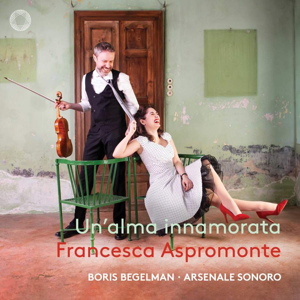
George Frideric Handel (1685-1759)
Un’alma Innamorata
Mi palpita il cor (HWV 132c)
Violin Sonata in G Minor, HWV 364a
Un’ alma inamorata HWV 173
Sonata a tre in G Minor, Op. 2 No. 6, HWV 391
Tu fedel, tu costante, HWV 171
S’un dì m’appaga la mia crudele, HWV 223 (premiere recording)
Francesca Aspromonte (soprano), Arsenale Sonore/Boris Begelman (violin)
rec. 2022, Auditorium “Arcangelo Corelli”, Fusignano, Italy
Booklet with Italian texts and English translations and notes
Pentatone PTC5187083 [67]
Handel’s secular cantatas are a large part of his catalogue, in various languages, with continuo or orchestral accompaniment, and for one or sometimes more voices. They are mainly from his early years in Italy (1706-1710), when the popes closed the opera houses and such cantatas were a less offensive, or just less scrutinised, form of dramatic music. Thus his long periods in Rome, supported and hosted by eminent patrons, are dominated not by sacred music but by cantatas in Italian, lasting 10-20 minutes, usually for solo voice and continuo, often with a violin, flute or oboe obbligato.
These pieces remained unpublished, so were virtually unknown until fairly recently. For Handel, they were a rich source of self-borrowing for arias in his operas – which is what they essentially are. So, they usually alternate recitative and da capo arias, opera-style, and are concerned with classical characters in thrall to the joys and disappointments of love. On this release, the vocal programme explores the usual vicissitudes of love, but selects pieces with a text which suggests the singer wishes to take the blame, or take back control, rather than be merely a helpless victim and blame Cupid.
Soprano Francesca Aspromonte writes in the booklet: ‘ – “Love made me do it”! No. It’s time to take responsibility.’ These cantatas are with violin obbligato, played by Boris Begelman who also directs the Arsenale Sonore, a small string band of four more violins, cello and double bass, plus archlute and harpsichord. This permits two short instrumental items, the Violin Sonata in G minor and the Sonata a tre in G minor. They add variety to the programme, and separate the main vocal numbers.
The programme begins with one of the better-known cantatas, Mi palpita il cor, written between 1710 and 1713. It exists in several versions, with obbligato flute, or obbligato oboe, or with flute and oboe. The CD documentation refers to the version catalogued as HWV 132, which is for oboe. Here it is played with that part on the violin, but the booklet makes no mention of this. It sounds completely plausible and is delightfully played, dovetailing in and around Aspromonte’s fine singing. She characterises each separately tracked section well, and depicts the flow of the piece between recitative and aria sections to reflect the inner drama of the male character fretting over whether his beloved Cloris will return his love.
In Un’alma innamorata, the protagonist chooses not to be the ‘slave to love’ depicted in its first aria section, but seeks to ‘disdain the […] harsh laws of love’ and ‘love more than one sweetheart’. Aspromonte again succeeds in her musical characterisation, and keeps the longish first aria moving along (7:28 in a cantata playing for just over 15 minutes). Arriving at the swifter second aria with its more promiscuous attitude, the singer demonstrates a light and joyous tone to match the carefree sentiment, and no little skill in some flexible coloratura. Begelman is also excellent in reflecting the light-heartedness, even if one might still like to hear one of the woodwind obbligato options.
Tu fedel, tu costante has, we learn for the booklet note, a second version HWV 171a ‘discovered only in 2015 in the private collection of Ton Koopman’. That date explains why my copy of Donald Burrows’s Master Musicians volume on Handel, published in 2012, insists that there is ‘no variant’ of the original HWV 171 – which is what he have here. (The booklet does not say what Koopman’s variant version consists of.) It was one of the earliest of these cantatas, completed in 1707. It opens with a quasi trio sonata, so is appropriately prefaced by the splendid real Trio Sonata HWV 391 written around the same time. The text has our protagonist rejecting an unfaithful lover ‘who loves a hundred beauties’. Dismissive lines such as ‘soon I will hate you as much as once I loved you’ lead into the fourth and final brief section, delightfully insouciant in mood.
The single aria that ends the programme, S’un dì m’appaga la mia crudele HWV 223, is a world premiere recording. It fits well enough into the theme of the album. It is a much later work, from 1738 or after, likely written to suit a particular singer for a particular opera production. It makes a most appealing close to an excellent disc.
Francesca Aspromonte is a persuasive advocate for this music, with her lovely fresh tone and ingratiating vocal manners, never too heavy for the material. Boris Begelman is an alert musical companion. His obbligati are often more of a musical contribution than that term might imply, and his ensemble sounds idiomatic in the two interpolated instrumental pieces. There is very good sound, as Pentatone taught us to expect. This disc will make an ideal introduction to a still little-known corner of a great composer’s output. I hope it enjoys the success it deserves, since I would welcome a follow-up album, maybe even a short series. There is plenty of such material to choose from.
Roy Westbrook
Help us financially by purchasing from





















